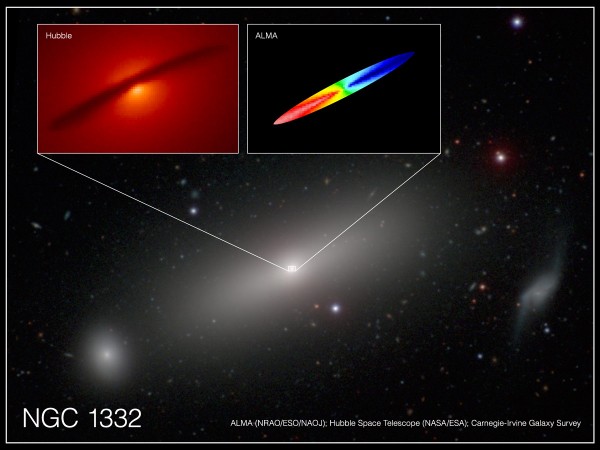By Ana Verayo, | May 08, 2016

Combined image of NGC 1332 shows the central disk of gas surrounding the supermassive black hole at the center of the galaxy.
Astronomers have now discovered a breakthrough method in determining the mass of a supermassive black hole that is located at the center of any galaxy. With the help of the Atacama Large Millimeter/submillimeter Array (ALMA) telescope, they determined the mass of a monster black hole known as NGC 1332, to possess 660 million solar masses.
Like Us on Facebook
The team have determined this exact mass measurement of this supermassive black hole by taking into consideration the interstellar gas and stars that are enshrouding it, along with analyzing the powerful effects of the massive gravitational forces emanating from the black hole itself. This colossal monster black hole is about 73 million light years from Earth.
According to lead author of the study, Aaron Barth from the University of California, Irvine, in order to measure a black hole with complete accuracy is absolutely challenging, even with the aid of the most powerful ground telescopes on Earth and even space telescopes.
To be able to do this, the team of astronomers measured how fast the carbon monoxide gases are travelling inside the black hole using the ALMA telescope, which also possesses the ability to observe the black hole's accretion disk.
The powerful ALMA facility is located in the Atacama Desert of Northern Chile, consisting of an array of 66 radio telescopes that can zoom in on the most minute wavelengths in the universe.
Barth explains that the process in calculating the mass of the black hole in the core of the galaxy, it is essential to obtain any speed measurement of the material that are orbiting around it. For more precision, zooming in on the the epicenter of the galaxy is most crucial since this is where the black hole's gravitational forces are the strongest. He adds that ALMA is a fantastic new scientific tool to carry out such observations.
These new findings revealed that the gases that are travelling near the core of the black hole's disk is currently speeding at 500 kilometers per second. Based on simulations, the team determined that NGC 1332 is 660 million times bigger than the sun. For further comparison, NGC 1332 is approximately 150 times bigger than the black hole located in the center of the Milky Way galaxy.
This new study is published in the Astrophysical Journal Letters.
-
Use of Coronavirus Pandemic Drones Raises Privacy Concerns: Drones Spread Fear, Local Officials Say

-
Coronavirus Hampers The Delivery Of Lockheed Martin F-35 Stealth Fighters For 2020

-
Instagram Speeds Up Plans to Add Account Memorialization Feature Due to COVID-19 Deaths

-
NASA: Perseverance Plans to Bring 'Mars Rock' to Earth in 2031

-
600 Dead And 3,000 In The Hospital as Iranians Believed Drinking High-Concentrations of Alcohol Can Cure The Coronavirus

-
600 Dead And 3,000 In The Hospital as Iranians Believed Drinking High-Concentrations of Alcohol Can Cure The Coronavirus

-
COVID-19: Doctors, Nurses Use Virtual Reality to Learn New Skills in Treating Coronavirus Patients







